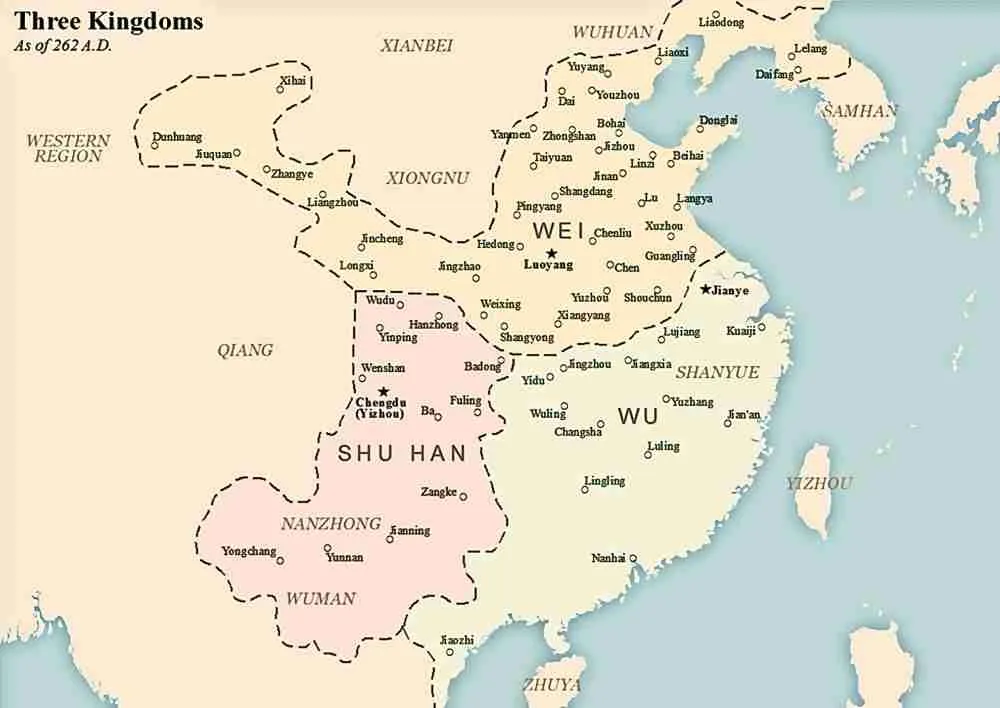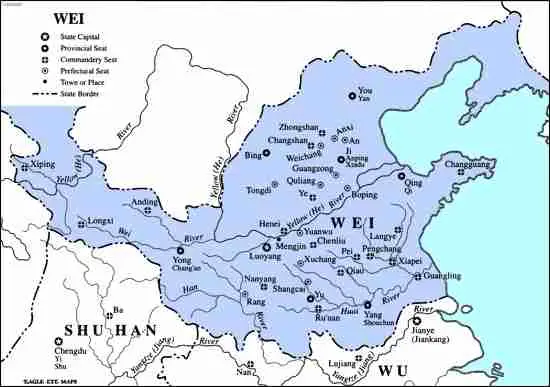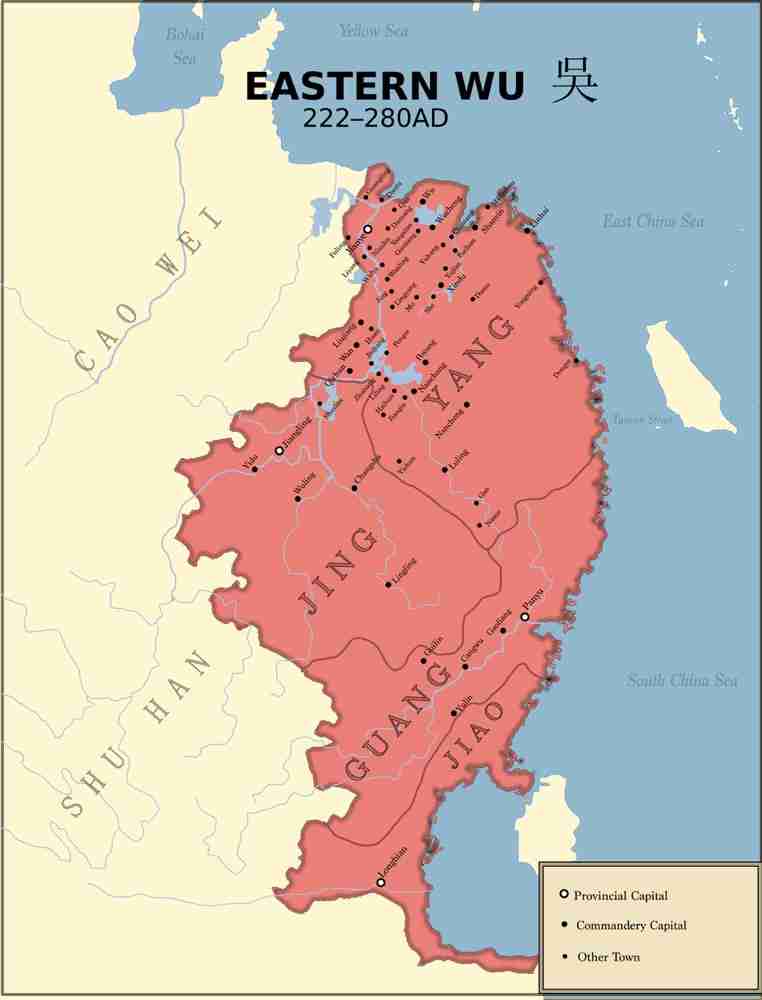The three kingdoms of ancient China, also known as the San-Kuo, refer to the trio of the Chinese Warring States that followed and ruled China after the Han Dynasty was conquered. The three kingdoms ruled between 220 and 280CE. And the Han Dynasty had ruled previously between 206BCE and 220CE.
During the brief disruption period in 25CE when the Han Empire was reconstituted as Dong Han or the Eastern Han. But by the end of the 2nd Century, the Eastern Han disintegrated into a state of extreme chaos, with its emperor turning into a puppet, ceding the throne in 220 to Cao Pi. This change started the Wei Kingdom from northern China, with two other Han generals installing themselves as emperors at the same time, taking over southern and western China. These were the Shu-Han or modern-day Sichuan province and the WU empire located south of the Yangtze River.
Between 263 and 264, the Wei gained control over the Shu-Han, although the throne was usurped 2 years later when Sima Yan took over the throne, forming the Jin Dynasty. The Jin Dynasty then conquered the Wu Dynasty, reuniting the country. Unfortunately, this win was short-lived as the dynasty fell apart soon after, leaving the whole country in chaos.
Although the 3 kingdoms survived for a very short time and did not contribute much to the arts and the current state of modern China, the Three Kingdoms period is still an important era in Chinese history with great political intrigue. It’s also seen as an era that was rather romantic and interesting and still played an integral role in China’s long history.
When Was The Three Kingdoms Period?

The Three Kingdoms period was between 220 and 280CE.
What Happened During The Years Between The Three Kingdoms
Well, the time that the Three Kingdoms reigned over a rather divided China is largely seen as a period during which the state of Wei was founded in 200AD, featuring the conquests of the Wu State under the Jin Dynasty.
In addition to the formation of the three states of Wei, Shu, and Wu, each run by an emperor who successfully led their kingdom until it was defeated by the stronger kingdom. But with three kingdoms ruling, there was a lot of infighting between the kingdoms. The middle part between 220 and 263 was, however, marked by a lot of stability in the military between the three rival states. However, the later years from the period featured the collapse of the tri-partite states. And the first kingdom to fall apart was the kingdom of Shu, which was conquered by the Wei kingdom. It was followed by the downfall of the Wei dynasty, which was conquered by the Jin Dynasty, and lastly, the Kingdom of Wu was conquered by the Jin Dynasty.
Cao Wei

Also known as the Wei, Cao Wei, formerly Wie, was one of the 3 main states from the Three Kingdoms. The state was in competition with the two other states over the supremacy of China. Its capital was located in Xuchang, and it was later moved to Luoyang, which was a state established in 220 by the Cao Pi. The state was created based on the foundation that was put up by Cao Cao, his father, as the reign of the Eastern Han Dynasty came to an end.
Cao Wei was, for the longest time, the strongest of the kingdoms, and they were able to successfully repel invasions by Shu Han, as well as Eastern Wu. In 263AD, the Cao Wei conquered the Shu Han following a short invasion, with the help of a rather corrupt eunuch called Huang Hao. In 265AD, Cao’s family was overthrown by Sima’s family, creating the Western Jin Dynasty that succeeded the Sima Family.
Eastern Wu Dynasty

This was one of the 3 states/ kingdoms that fought for rule over China during the Three Kingdoms Era. It controls a large section of China in the south and the southern territory. It buffered Shu Han to the North West of China.
Eastern Wu or Dong Wu existed between 229 and 280AD, and it was the surviving state by the time the Jin Kingdom won the fight over what was left of the Three Kingdoms.
Shu Dynasty

Shu Dynasty dates back to 23, and it rose to the throne between 224 and 225 during the southward campaigns. The state was, however, conquered in 263/264 by the Wei dynasty. During its reign, the Shu Dynasty had control over the present-day Sichuan province.
Notably, between 238 and 262, the Shu Dynasty had successfully launched 11 expeditions attacking the Wei Kingdom, and though they won more battles than they lot, these wars meant a significant loss in terms of money, food, as well as human recourses. These all weakened the Shu significantly, and when the Wei invaded the Shu Dynasty in 262, where Liu Shan was the last king, he opted to surrender to the Wei. Upon surrender, Liu Shan would be allowed to live out the rest of his days in peace in Wei’s capital, Luoyang.
Who Won The Three Kingdoms
In the late period of the Cao Wei dynasty, real power gradually fell into the hands of Sima Yi. In 263 AD, Sima Zhao of Cao Wei launched a campaign to annihilate Shu Han, which resulted in the fall of Shu Han. On February 8th, 266 AD, the power behind the throne of Cao Wei, Sima Yan, forced Emperor Yuan of Cao Wei to abdicate and established a new state called “Jin”, which marked the end of the Three Kingdoms period and the beginning of the Jin Dynasty. In the first year of the Taikang era (280 AD), Emperor Wu of Jin launched a massive campaign against Wu, and Sun Hao surrendered, resulting in the annexation of Wu and the unification of the country under the Jin Dynasty. Thus, the three kingdoms were reunited under the Jin Dynasty.
Medicine during the Three Kingdoms Period
Hua Tuo was a renowned physician during the Three Kingdoms period, with comprehensive knowledge in internal medicine, obstetrics, pediatrics, and acupuncture, among other fields. He was particularly skilled in surgery and was known as the “founder of surgery” and the “surgical saint”. Hua Tuo is credited with using “mafeisan” to anesthetize patients before performing abdominal surgery, making him the earliest recorded practitioner of general anesthesia in the history of medicine. He also created a series of physical exercises called “Wuqinxi” (Five Animal Frolics) that imitated the movements of tigers, deer, bears, apes, and birds to promote health and well-being. Despite his medical achievements, Hua Tuo was executed for refusing to serve the warlord Cao Cao. Unfortunately, his medical book, “Qingnang Shu”, is now lost.
Three Kingdoms Period Chinese Philosophy
The philosophies of Confucianism, Taoism, and Legalism rose to prominence during the Three Kingdoms era. The intellectual and cultural climate of the time was shaped in large part by each of these institutions.
The teachings of Confucius and Mencius continued to shape the moral and ethical norms of society, and Confucianism remained the dominant ideology of the ruling class. Scholars of Confucianism hammered home the values of learning, respect for authority, and leading by example. Scholars of the Confucian classics held high positions in government and society, and their knowledge was widely sought after.
Individualism and spirituality, two themes central to Taoism, were also influential during this time. Taoist sage Zhuangzi popularized the concept of Wu Wei, or non-action, which emphasized a life in harmony with the natural world and the cosmos. During this time, Taoist alchemists were also widely respected for their efforts to create a formula for eternal life.
The influence of legalism, which had been favored by the Qin dynasty, persisted into the Three Kingdoms era. Some rulers adopted legalist ideas, perceiving the necessity of draconian laws and punishments to maintain social order and exert control over the populace.
During the Three Kingdoms era, Buddhism emerged as a fourth major school of thought alongside Confucianism, Taoism, and Shinto. Some Chinese emperors encouraged the spread of Buddhism throughout China by welcoming Indian Buddhist monks and their teachings.
Metaphysics, a revision of Confucianism, rose to prominence as the dominant philosophical school during the Wei-Jin era. Its foundational ideas originated in the Laozi, Zhuangzi, and Yijing, the three primary texts of Daoism. The Prajna doctrine of Buddhism, which was steeped in dialectical thought, was absorbed and transformed by literati and scholars, and thus played a role in the evolution of knowledge beyond the realm of classics. During the Wei-Jin era, a school of thought known as “qingtan” favored by metaphysical scholars became increasingly popular. The years 240–248 were a time of ferment, spearheaded by He Yan and Wang Bi. Scholars of metaphysics advocated for the concept of “unifying the root and the phenomenon,” which held that in order to comprehend a phenomenon, one must first grasp its fundamental principles, or “root.” They believed that “all things are produced from nothingness,” with the “root” being the “Dao,” which they equated with the formless “nothingness” (principle, trend). Sima Yan eventually overthrew the Wei and founded the Jin dynasty. The Seven Sages of the Bamboo Grove, including Ruan Ji, Ji Kang, and others, steered the conversation away from abstract philosophical concepts and toward the value of each individual human life. The political climate was tense back then, and the Sima clan oppressed the nobility while disguising themselves in the study of Confucianism. Rather than promoting the liberation and natural sincerity of human nature, as did Ruan Ji and Ji Kang, they advocated the oppression of human nature through ritual and law. They pioneered the practice of this theory, starting a movement toward greater personal freedom. After the Western Jin dynasty, qingtan became popular on the political stage, with high-ranking officials espousing lofty ideals and portraying themselves as a class apart from the common people. To fix the “false and erroneous” parts, Pei Yin suggested revering “existence” and “correcting nature.” Further evidence that “Confucianism” is “natural” was provided by Guo Xiang, concluding that metaphysics had run its course.
Literature during the Three Kingdoms Period
The literary works of the Cao Wei period, which can be split into the earlier Jian’an literature and the later Zhengshi literature, are the backbone of the Three Kingdoms canon. The Jian’an literature, also known as the “Han-Wei style” or the “Jian’an style,” was written in response to the weak and feeble style of poetry of the time. Cao Cao and others’ devotion to the written word drew artists from far and wide. The “Three Caos” and the “Seven Jian’an scholars” are two iconic literary figures from Jian’an literature. In addition to Han Dan Chun, other authors worth mentioning are Cai Yan, Fan Qin, Lu Cui, Ding Yi, Yang Xiu, and Xun Wei. Cao Cao’s works, such as “Short Song Style,” “Walking out of Xiamen Style,” and “Let County Enlighten Its Own Ambition Style,” are examples of his profound and majestic style, written in a simple and solemn manner. Both Cao Pi and Cao Zhi were gifted authors; however, it was Cao Pi’s critical essays in “Dianlun” that contributed to the introspective growth of Chinese literature. Cao Zhi, author of “The Goddess of Luo River Style,” possessed a romantic disposition. The Seven Scholars of Jian’an, along with Cai Yan, Yang Xiu, and others, were preoccupied with the here and now. Cai Yan’s “Eighteen Songs of a Nomad Flute Style,” for example, reflected the social upheaval and hardships that the people had endured following the fall of the Han Dynasty.
Invention during the Three Kingdoms Period
During the War of the Three Kingdoms, the Shu Han had trouble getting food to their troops fighting in Cao Wei’s territory because of the difficult mountainous terrain. Pu Yuan created the “wooden ox,” a one-wheeled cart, to address this issue. The “Biography of Pu Yuan” states that the cart was “two meters long and had a single axle, and when pulled by a wooden ox, it could transport a year’s worth of grain in four steps.” For over a millennium, people all over the world have relied on this one-of-a-kind cart, which excelled on both smooth roads and narrow trails.